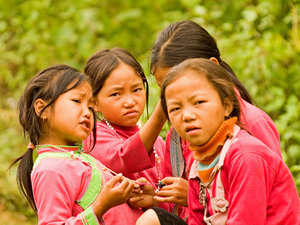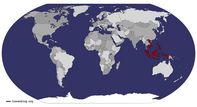Advertisement
Published: October 17th 2012

 Young children
Young children
Some young hmong children we met on our Cat Cat village trekA tribute to the hmong people of Sapa
Our 10 day stay in Sapa has come to an end. A lot of people would think that 10 days in Sapa is way too much. We were in the same boat at the beginning of our stay. However as time passed by, we got deeper and deeper beneath the skin of this little community in the north of Vietnam and really got to appreciate this place and its people. This is a great privilege having plenty of time to explore.
One of our many highlights was the encounter with the hmong people. In the beginning we found them rather annoying. They are eager sales people and really push it to the limit. They almost match the Egyptians in their effort to sell their stuff. However they do accept a friendly “no thank you” (ok, more like 15-20 no thanks). But a smile helps a lot, and when you take the time to communicate with them, you’ll find out that they have a great sense of humor and they do smile a lot.
Our experience with the hmong people in Sapa is that they live

 Hmong girl on the market
Hmong girl on the market
The hmongs are very colorfula simple life. However most of them do have a scooter and a mobile phone. However their houses don’t have running water, heat or toilet. They make a living of growing rice and their animals. The women are very artistic and good at making small woven things like small bags or wallets. Also they make jewellery. They try to make a few bucks selling these things to tourists. Typically you can buy a small item for around a dollar or two (remember to bargain).
In Sapa the girls typically get married around the age of 16 and will have their first child around the age of 18. I met two young mothers aged 18 and 21 (Lilli and Zu). From a Danish point of view, I think that what they overcome is pretty impressive. They are taking care of the household, take care of their child and make an income by selling stuff. Often they have to walk 10-12 kilometers to get to Sapa (hilly terrain!!!). Sometimes they are lucky and catch a scooter ride (overweigt certainly isn’t a problem for the hmongs (Maybe worth to study by an weightwatcher expert). The English they know, they have

 Hmong childrens playground
Hmong childrens playground
These children made a slide out of a big rock and straws of rice.learned by talking to tourists. They can’t read or write English. I don’t even know if they can read and write their own language. At least the children today go to school for 9 years, so probably they get to know all the basics.
From a Danish perspective, we would probably say that the hmongs are pretty poor measured in monetary terms. But one can ask the question, are the hmongs in reality tougher than the average Dane? How many Danish young mothers can overcome the tasks of Lilli and Zu? How many Danish women would like to give birth to their children in a home built rather primitive house? In Vietnam they don’t really have a social security system as we know it from Denmark. The Vietnamese take care of themselves or get help from the family. In Denmark people are whining when they lose their government financial support after 2 years unemployment. Maybe we could learn a little from the hmong people?
When moving around in Vietnam we witness a lot of interesting constellations of commodity- and people transport on their scooters. Dogs, chicken, pigs and water buffalo’s add some color in

 Red Dzao woman in the ricefield
Red Dzao woman in the ricefield
Very friendly red dzao harvestingthe streets. Somehow it all seems to work. The dogs have learned to cope with the traffic and we have yet to experience a dogfight or aggression towards people. You can’t help to think, if Denmark has too many regulations. If your dog moves around freely, you’ll get a fine. Danish dogs have a habit of aggression towards other dogs (well some). Has a cow broken out of a fence, the police will be called. Two people on a scooter equal a fine. If you have forgotten the seatbelt to your child, you will be fined (3 times and you’ll lose your driver license), and people will judge you as an irresponsible parent. Things develop all the time. When Inge and I were kids, the cars didn’t even have seatbelts in the rear. To our big surprise, we somehow managed to survive our childhood (we didn’t wear crash helmets on our bikes either). In the 70’s we managed to get around 7 children into one car on our way to a handball match (including the ones in the back of the car). That would be an absolutely no go today. But in Vietnam you can (although you need to wear

 What a smile
What a smile
Smile to the world, and the world smiles back :)a crash helmet on the scooters). Of course the regulations are in the interest of protecting the citizens. But does it always make sense? Would it be all right to leave more responsibility to the people, who will have to take the consequences if things go wrong?
Well, enough of pocket philosophy for now. The hmongs way of living shows that we Danes should take more responsibility of our own. We are extremely privileged compared to the hmongs, but we do not always appreciate that.
The photos are a tribute to the hmong people.
The Hmong people – a little more information
The hmong people is a people without a nation. Their origin is the south of China. They have spread to Thailand, Laos and Vietnam. Even in the USA there is a population of approximately 200.000,- hmongs. China still has the highest number of hmongs with a population around 9,6 million. The estimate is around 2 million in the other countries.
The hmongs are typically farmers growing rice and vegetables. Usually they will have a few animals that they slaughter for special

 Red Dzao
Red Dzao
Red Dzao in traditional dress and with the characteristic basket.occasions. Our hostess, Sin Sin, even invited us to try her local rice wine. Wow, heavy stuff. As she said, that when they drank too much, the children complained that they just talked bla bla bla. In this respect I guess they really are much like Danes J. The hmongs of Sapa supplements their income by guiding tourists and selling homemade handicrafts. The different tribes wears the same clothes and are easy recognizable. Their clothes is made of hemp and looks itchy. They wear small plastic sandals and don’t have problems holding their balance on the sometimes slippery paths. We met a Dutchman who had been on a hike, and gone on his behind a few times. The hmongs didn’t! Well, they do have a lower point of gravity. They probably wouldn’t make good basketball players. The photo on our first blog of me (C) and 3 hmong women illustrates the size difference between the European tribe and the hmong tribe. They are rather small (or are we big?).
The hmong people fought on the US side in the Vietnam war. They were active along the Ho Chi Minh trail, trying to obstruct the supply line from

 Hmong dancer
Hmong dancer
Graceful young hmong dancer at cultural shownorth to south. After the war ended the hmongs were persecuted in Laos!!!! Some hmongs escaped to the US and as a curiosity the hmongs went on the big screen for the first time in the rather good Clint Eastwood movie, “Gran Torino”. We didn’t know that it was hmong people when we watched the movie. We have to watch it again.
Our impression of the hmongs in Sapa was that they are not persecuted in Vietnam, but they tend to stick to themselves. Some of them get married to Vietnamese people and foreigners. In the recent past marriages were arranged and the groom had to work for the parents of the bride until the birth of the first child. Today they decide for themselves. We are not aware how the boys and girls meet up. We certainly didn’t see a lot of bars and discos. Since most hmongs don’t have a computer net dating is also no option. Hmong men and women are equal and by a little internet research we actually found out, that the young ones often meet in the so called “Love markets”. Well, why not? Perhaps a business idea in Denmark?

 Hmong wisdom
Hmong wisdom
I like this mans expression. It reminds me of wisdom and life experienceIt will be exciting to witness if the hmongs can/will keep their culture. We saw young hmongs surfing on our hotel. They have mobile phones and they watch how we live. Will they be interested in living in a relative simple and poor way?
In the Sapa area you also find quite a few “Red Dzao”. Another tribe that also originates from China. They differentiate from the black hmongs by wearing a red headgear and their clothes is also different. It seems like their way of living resembles the hmongs. There is no hostility between the tribes and it happens that there are inter tribal marriages.
If you go to Sapa, you will certainly run into the hmongs. They are very visible in the street life. One of the first things we noticed, was their very dirty hands (or so we thought). By second thought we found out that it is from dying their clothes. When Sin Sin cooked for us, she washed all the vegetables. Even though she used her own chop sticks to hand us food and there were dogs and cats in the “kitchen”, we didn’t experience stomach issues.

 Hmong boy
Hmong boy
You see his hands. Not dirt, dyeBy the way, the food was very tasty and there was plenty of it J.
If you go to Sapa, we highly recommend a private trek with a local hmong. You will walk though beautiful landscapes and it will be interesting to visit a real hmong home. Have a great time J
Advertisement
Tot: 0.107s; Tpl: 0.013s; cc: 13; qc: 67; dbt: 0.0614s; 1; m:domysql w:travelblog (10.17.0.13); sld: 1;
; mem: 1.2mb






















Village Craft Planet
non-member comment
Exceptional photos
Thank you for this candid portrait of the Sapa, and for sharing the local colors and style. We have linked to your blog post from http://www.facebook.com/VillagecraftPlanet!